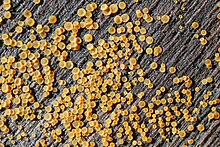Orbilia
Jump to navigation
Jump to search
| Orbilia | |
|---|---|

| |
| Orbilia xanthostigma | |
| Scientific classification | |
| Domain: | Eukaryota |
| Kingdom: | Fungi |
| Division: | Ascomycota |
| Class: | Orbiliomycetes |
| Order: | Orbiliales |
| Family: | Orbiliaceae |
| Genus: | Orbilia Fr. (1836) |
| Type species | |
| Orbilia leucostigma (Fr.) Fr. (1849)
| |
| Species | |
|
~58, see text | |
| Synonyms[1] | |
Orbilia is a genus of fungi in the family Orbiliaceae. Anamorphs of this genus include the Arthrobotrys, Dactylella, Dicranidion, Dwayaangam, Helicoön, Monacrosporium, and Trinacrium.[2] The genus was established in 1836 by Elias Magnus Fries to accommodate the species Peziza leucostigma.[3] The mycologist Josef Velenovský wrote articles describing species found in Bohemia and Moravia (Czechoslovakia).[4][5] In 1951, Fred Jay Seaver recorded 20 species in North America,[6] and R.W.G. Dennis later described 9 species from Venezuela.[7] According to the Dictionary of the Fungi (10th edition, 2008), there are about 58 species in the genus.[2]
Species
- Orbilia acuum
- Orbilia alnea
- Orbilia antenorea
- Orbilia arundinacea
- Orbilia aurantiorubra
- Orbilia auricolor
- Orbilia bannaensis
- Orbilia bomiensis
- Orbilia brevicauda
- Orbilia coccinella
- Orbilia comma
- Orbilia corculispora
- Orbilia cruenta
- Orbilia cunninghamii
- Orbilia curvatispora
- Orbilia cyathea
- Orbilia delicatula
- Orbilia dorsalia
- Orbilia epipora
- Orbilia eucalypti
- Orbilia euonymi
- Orbilia falciformis
- Orbilia fimicoloides
- Orbilia gambelii
- Orbilia leucostigma
- Orbilia luteorubella
- Orbilia luzularum
- Orbilia milinana
- Orbilia pellucida
- Orbilia pilifera
- Orbilia piloboloides
- Orbilia pisciformis
- Orbilia quercus
- Orbilia rectispora
- Orbilia retrusa
- Orbilia sarraziniana
- Orbilia scolecospora
- Orbilia tenebricosa
- Orbilia tricellularia
- Orbilia umbilicata
- Orbilia vermiformis
- Orbilia vinosa
- Orbilia xanthostigma
- Orbilia yuanensis[8]
References
- ^ "Orbilia Fr. 1836". MycoBank. International Mycological Association. Retrieved 2011-12-13.
- ^ a b Kirk PM, Cannon PF, Minter DW, Stalpers JA (2008). Dictionary of the Fungi (10th ed.). Wallingford, UK: CAB International. p. 485. ISBN 978-0-85199-826-8.
- ^ Fries EM. (1836) [1835]. Corpus Florarum provincialium suecicae I. Floram Scanicam (in Latin). p. 343.
- ^ Velenovský J. (1934). Monographia Discomycetum Bohemiae. Vols. I and II. Publ. by the author, Prague. 436 p.
- ^ Velenovský J. (1947). "Novitates Mycologicae Novissimae." Opera Bot. Čech. 4: 1–158.
- ^ Seaver FJ. (1951). The North American cup-fungi (inoperculates). Publ. by the author, New York. 428 p.
- ^ Dennis RWG. (1970). Fungus flora of Venezuela and adjacent countries. Kew Bulletin Additional Series III. Cramer, Lehre. 531 pp.
- ^ Qiao M, Li J-Y, Baral H-O, Zhang Y, Qian W-Y, Su H-Y, Yu Z-F (2015). "Orbilia yuanensis sp. nov. and its anamorph". Mycological Progress. 14 (2). doi:10.1007/s11557-015-1022-6. S2CID 17847136.
External links